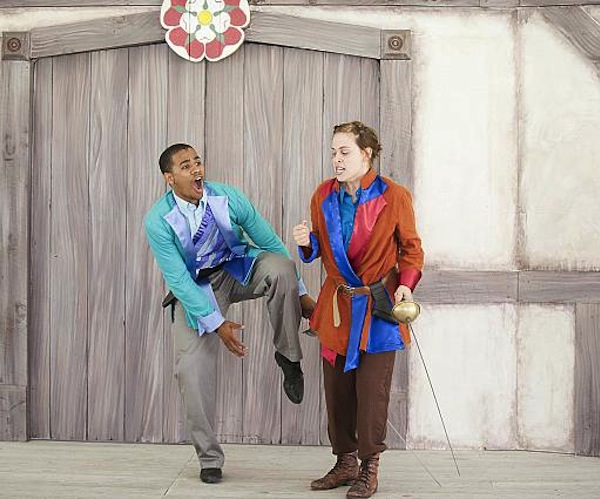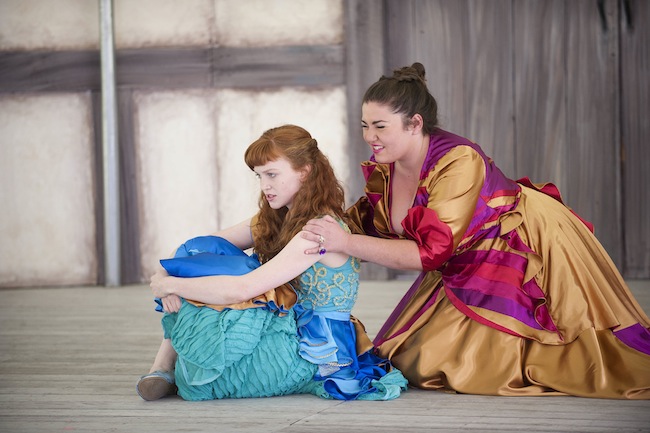Theater Review: Shakespeare & Co’s “The Servant of Two Masters” — An Old Farce, Refreshed
Director Jenna Ware’s adaptation (a world premiere) of Carlo Goldoni’s inspired zaniness puts a delightfully distinctive spin on a classic of clowning.
The Servant of Two Masters by Carlo Goldoni. Adapted and directed by Jenna Ware. Songs by Luke Reed. Presented by Shakespeare & Company at the Rose Footprint Theatre in Lenox, MA, through August 23.

Kyle V. Martin and Sara Holt in rehearsal for Shakespeare and Company’s “The Servant of Two Masters.” Photo: Elizabeth Aspenlieder.
By Ian Thal
The Servant of Two Masters is without question one of the most revived of Carlo Goldoni’s comedies. Some recent local productions: Yale Repertory Theatre‘s adaptation was imported into ArtsEmerson’s 2012-13 season, while Richard Bean’s version One Man, Two Guvnors, set in 1960s Brighton, England, which premiered at London’s National Theatre in 2011, was presented in September 2013 by the Lyric Stage Company of Boston. In theater history survey courses, when the topic turns to commedia dell’arte, this is apparently the go-to script.
Ironically, Goldoni (1707-1793) did not see himself as writing in the genre of commedia. Documentary evidence places the origins of the commedia in the middle of the 16th century, coinciding with the legal incorporation of Europe’s first professional acting troupes in Italy. The style is rooted in an actor’s theater, an approach that emphasizes the prowess of individual performers, in particular their improvisational skills. So in 1743, when Goldoni, already the author of libretti and tragedies, adopted the stock characters and plot devices common to the commedia, he ended up revolutionizing the form. By the time he revised The Servant in 1753, he had completely eliminated improvisation and subordinated the actors to the script.
Though Shakespeare and Molière penned commedia-inspired work, Goldoni’s comedies do not contain poetry on par with the former or present biting social satire in the mode of the latter (to whom Goldoni compared himself unfavorably). Still, Goldoni’s work surpasses both dramatists in terms of creating plots so convoluted that the final scene generally includes a recap dedicated to clearing up every confusion, misunderstanding, and deception, for the benefit of both the characters and any audience members who were too slow to keep up.
The play opens as Doctor Lombardi (Barby Cardillo), a lawyer, and Signora Pantalone Dei Bisognosi (Concetta Russo) are finalizing the betrothal of their children Slivio (Kyle V. Martin) and Clarice (Ally Allen). (Director Jenna Ware, working with a mostly female cast, alternately puts them in male roles or changes the gender of Goldoni’s original characters.) It is a perfect match of business interests (the parents) and true love (the children), but the marriage is possible because of the recently reported death of Clarice’s previous fiancée, Federigo Rasponi, one of Pantalone’s business correspondents in Turin. Suddenly, a servant, Truffaldino (Jennie M. Jadow), bursts in and announces that his master Federigo Rasponi is not only alive, but is waiting to be invited inside to meet his fiancée as well as his soon-to-be mother-in-law. In truth, Federigo was killed in a duel: the master at the door is actually his sister, Beatrice (Sara Holt), who has taken her brother’s identity both to collect money that Pantalone owed her brother and to pursue her brother’s killer, Florindo (Adam Huff). She does not seek to avenge Federigo – but to marry Florindo. The duel had been fought because Federigo had refused to bless their betrothal.
With Federigo seemingly alive, the betrothal between Clarice and Silvio is void, as is the alliance between Pantalone and Doctor Lombardi. Meanwhile, because Beatrice is inattentive to her servant’s need for food, Truffaldino hastily takes a second job with the recently arrived Florindo, and is forced to engage in subterfuge in order to hide the fact that he is drawing two paychecks from two jobs.
These are only the first two scenes in an increasingly complicated narrative. While Truffaldino’s scheme take center stage, Beatrice’s deceits involve getting greater amounts of money, and she creates greater discord as she enlists both Brighella the innkeeper (Tyisha Turner), a fellow Torinese, and her dead brother’s betrothed in her plans.
Director and adaptor Jenna Ware is no stranger to the Goldoni repertoire (among my first assignments for The Arts Fuse was a review of her 2011 adaptation of The Venetian Twins). She has developed an admirably personal style when staging the Venetian playwright. Unlike Yale Repertory’s recent production, Ware neither incorporates the centuries-old masks associated with her characters, nor does she embellish her script with allusions to theater history, pop culture, and local color. She favors a speedy and efficient treatment of the clockwork plot. Indeed, with Ware, it’s often difficult to discern where her script ends and her work as a director, that is, a crafter of tableaux and blocker of action, begins. Every aside, every set piece seems perfectly timed.
Ware’s affection for comic mise-en-scène puts a distinctive stamp on the script’s set pieces and the musical intermezzi, which here feature original songs by Luke Reed (guitarist Josie Wilson provides accompaniment). One of the memorable musical numbers give us Truffaldino as a food obsessed blues singer accompanied by “The Peanut Butter and Jelly Singers”: the tune becomes part of the elaborate doings that set up the stage for the dinner scene, as well as the occasion for a percussive dance that incorporates bowls and other props along with stomping feet.
Given that 18th century dueling culture is a necessary part of the story, fight choreography is essential. Jonathan Croy, who also worked with Ware on The Venetian Twins, again gives each sword wielder a distinctive style that reveals something about his or her character. Huff’s Florindo, for instance, is a man who has killed in the name of love and honor, but he takes no pleasure in what he has done. When he draws his sword, he feels its full weight, and does not embellish his swings with showy moves. Florindo is a man who believes that when he saved his own life he may have lost everything that made existence worthwhile: that melancholy is evident when he slouches at the dinner table or when his hand goes to his hilt. Meanwhile, Holt’s Beatrice is capable with a sword, but only skilled enough to parry blows until external forces intervene. She is left exhausted, a reminder that she is in well over her head when it comes to maintaining her deception. These are unusual interpretations of the characters of Beatrice and Florindo, who are more often portrayed as flamboyant and swaggering, easily prone to violence (indeed Florindo is sometimes envisioned as more of a capitano than an inamorato).
Meanwhile, Martin’s Silvio is everything that the Torinese lovers are not. As son of a rich Venetian attorney, he appears to have had the best fencing teachers money can buy — his swashbuckling sword cuts the air effortlessly. He is acrobatic, often leaping and needlessly embellishing his en gardes with a balletic demi-rond de jambe. Silvio’s blade is the lightest of all. While his skills would intimidate any challenger, he has probably never killed or maimed anyone. Thus he has never learned the moral consequences of his actions. Silvio’s mercurial blade is the perfect metaphor for his easy-to-trigger jealous rage. He callously rejects Clarice’s assurances that she still loves him; he can only see that she has been taken into his apparent rival’s confidence.

L to R: Ally Allen, Concetta Russo in rehearsal for Shakespeare and Company’s “The Servant of Two Masters.” Photo: Elizabeth Aspenlieder.
The fact that Ware, Croy, and their cast have discovered dramatic subtexts rarely seen in productions of The Servant of Two Masters does not mean they have lost sight of just how funny this play can be. The cast have their lazzi together. Allen’s Clarice routinely protests her powerlessness by throwing herself face-down on the stage and pouting, with little concern about where her skirts and petticoats fly. Her maid, Smeraldina (Caitlin Kraft) is so overcome with anxiety over both of her mistress’ prospects (and her own potential romance with Truffaldino) that her fidgeting extends to how she stretches her mouth, hangs her head, twists her ankles and curls her toes. Tyisha Turner’s Brighella is so solicitous that she always stands in a perfect first position, engaging in quick relevés and demi-pliés to punctuate her exchanges with her clientele.
Of course, the center of every production of The Servant of Two Masters, is the servant, and Jennie M. Jadow is an energetic and precise Truffaldino who comfortably nests in the confusion he generates, bursting into a chant at the prospect of food or pacing in a circle around the stage as if to work off a little of the madcap humors coursing through his blood. Truffaldino’s antics as he serves dinner to both his masters at once is in Goldoni’s script, but Jadow makes the foodie’s japes her own as she slowly rolls about the stage, trying neither to be seen nor drop the plates.
With the exception of the green, lavender, and purple robes of Doctor Lombardi (the sole concession to the mask tradition is that she wears spectacles), Stella Schwartz’s brightly colored costume designs tend to depart from the iconic outfits associated with commedia characters. Truffaldino’s outfit – with its deep pockets, over-sized buttons and cap – is zany, but in a different manner than the motley patchwork or lozenge patterns one typically associates with either Truffaldino or his cousin, Arlecchino. Likewise, rather than garbed in the red-clad, yellow-slippered (agile) decrepitude traditionally associated with Pantalone, Russo is dressed as a confident and elegant businesswoman. Asymmetry and diagonal lines, whether in the hemlines of the women’s skirts or the vests of the male suitors, are the dominant motif.
While Goldoni’s comedies will never be heady, they are always entertaining, and Ware and her talented troupe have put a delightfully distinctive spin on a classic of clowning.
Ian Thal is a performer and theatre educator specializing in mime, commedia dell’arte, and puppetry, and has been known to act on Boston area stages from time to time, sometimes with Teatro delle Maschere, and on occasion served on productions as a puppetry choreographer or dramaturg. He has performed his one-man show, Arlecchino Am Ravenous, in numerous venues in Massachusetts and Rhode Island, and is currently working on his second full length play; his first, though as-of-yet unproduced, was picketed by a Hamas supporter during a staged reading. Formally the community editor at The Jewish Advocate, he blogs irregularly at the unimaginatively entitled From The Journals of Ian Thal, and writes the “Nothing But Trouble” column for The Clyde Fitch Report.
Tagged: Carlo Goldoni, Jenna Ware, Shakespeare and Company
